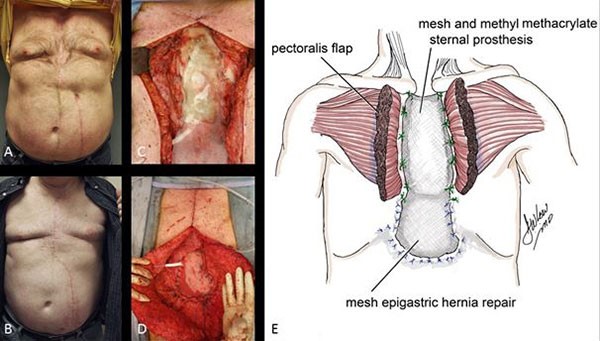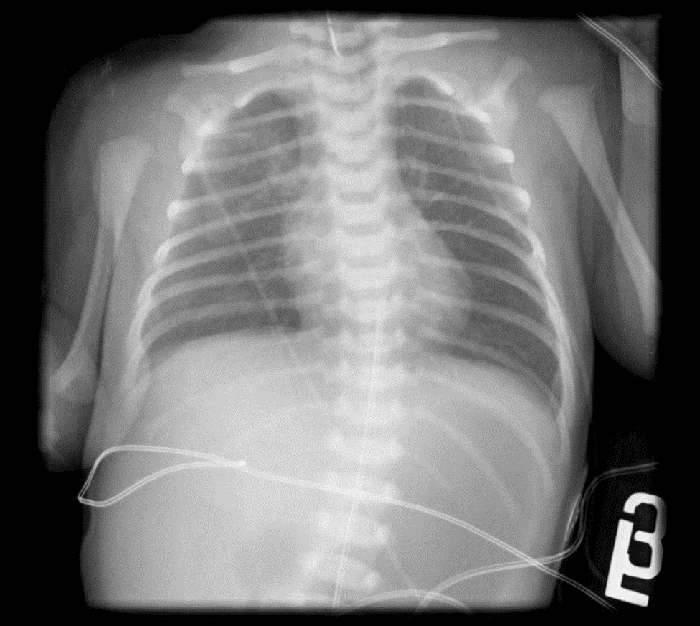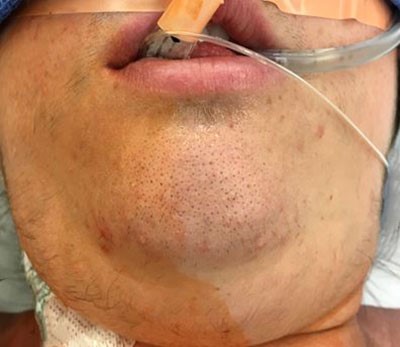Figure 2. Intraoperative image of a bifurcated ascending aorta to right subclavian and right common carotid artery bypass (under the preserved innominate vein retracted and marked by white vessel loop), right to left common carotid artery bypass, and two ascending aorta-coronary artery saphenous vein grafts. R SC: right subclavian artery graft, R CC: right common carotid artery graft, L CC: left common carotid artery graft, CABG: saphenous vein coronary artery bypass grafts.
Perfusion to the brain during the cerebrovascular reconstruction was achieved with retrograde cannulation of the left axillary artery to provide flow to the dominant patent left vertebral artery. Postoperatively, while in cardiac rehabilitation, the patient experienced repeated vertebrobasilar symptoms, likely due to her residual left subclavian artery stenosis proximal to her dominant left vertebral artery resulting in posterior cerebral circulation ischemia. The patient returned several weeks later for a planned supraclavicular approach left carotid to subclavian artery bypass grafting with an 8 mm PTFE graft after her cardiac rehabilitation was completed. She currently enjoys full resolution of her symptoms, her atrial fibrillation is treated, and she no longer requires anticoagulation for thromboembolism prophylaxis.
Discussion
Traditional surgical therapy for supra-aortic trunk vessel stenosis involves open surgical transthoracic repair, traditionally through median sternotomy.2-4 Methods include endarterectomy and aorta to innominate/common carotid/subclavian artery bypass.5 Indications for revascularization are atherosclerotic occlusive disease and inflammatory arteritides. Median sternotomy provides easy access to the brachiocephalic artery, right subclavian artery, and bilateral common carotid arteries. Configuration of direct repair depends on the diseased vessel(s) involved. Through a median sternotomy, the right subclavian and bilateral common carotid arteries can be revascularized. Left subclavian artery access can be gained by left anterior thoracotomy. To reduce morbidity and mortality associated with transthoracic repair, extra-anatomic revascularization such as carotid-subclavian bypass, carotid-subclavian transposition, and carotid-carotid bypass were later championed with improved results.6,7 Combined patency of supra-aortic trunk endarterectomy and anatomic or extra-anatomic bypass surgery has been reported as high as 91% at 10 years, and 89% at 15 years.8
Endovascular therapy for atherosclerotic supra-aortic trunk disease was initially met with enthusiasm due to significantly decreased mortality compared to open surgery.9,10 Although endovascular recanalization of chronically occluded great vessels is possible, it requires significant endovascular expertise. Some authors advocate for multiple arterial access points for use of distal embolic protection devices. Due to the degree of calcification in occlusive lesions, the initial failure rate of endovascular therapy for occlusive lesions has been reported as high as 50%–80%.11,12 Furthermore, compared to extra-anatomic bypass, angioplasty and stenting has poorer long-term patency (97% at five years vs. 82% at four years).13 In a contemporary series of 114 patients, van de Weijer and colleagues14 reported treating symptomatic patients with aortic arch branch disease. While they reported over 90% technical success and survival after two years, they also reported 19 patients who developed symptoms of restenosis at the target vessel and eight patients who developed contralateral stenosis who required re-intervention. Direct comparison by Takach and colleagues of surgical vs. endovascular revascularization of single brachiocephalic vessel disease corroborated these results. In 391 patients at five years postprocedure, freedom from failure rate was 92.7% in the surgical group and 83.9% in the endovascular group.15 Finally, there is evidence of mid- to long-term restenosis attributed to stent fatigue and fracture, particularly in the presence of significant calcification of the atherosclerotic plaque.16 Therefore, in spite of the initial appeal of minimally invasive catheter-based therapy, endovascular supra-aortic trunk repair with balloon angioplasty and stenting has fallen out of favor.
There are no consensus guidelines pertaining to endovascular vs. open repair of the supra-aortic trunk vessels. Although long-term patency is superior for surgical revascularization, endovascular therapy minimizes perioperative morbidity related to sternotomy and expedites postprocedural recovery. Therefore, supra-aortic trunk revascularization must be tailored to individual patients’ circumstances, operator skill and preference, and institutional capabilities. While planning for open repair, multidisciplinary collaboration maximizes treatment potential. In this case, supra-aortic trunk revascularization, coronary revascularization, and CryoMaze for atrial fibrillation were all accomplished expeditiously through a single median sternotomy. Since the patient’s stroke risk was mitigated from the first procedure, left arm revascularization was staged to minimize operative time and expedite cardiac recovery. When cardiac rehabilitation was completed and the patient had recovered from her initial operation, she returned for left carotid-subclavian bypass through a standard supraclavicular approach. She now enjoys full resolution of her symptoms.
Conclusion
Atherosclerosis is the leading cause of death and disability in the United States. Since there are many manifestations of atherosclerosis, the best medical therapy is with risk factor optimization and operative adaptations.
Lessons Learned
Although long-term patency is superior for surgical revascularization, endovascular therapy minimizes perioperative morbidity related to sternotomy and expedites postprocedural recovery. Supra-aortic trunk revascularization must be tailored to individual patients’ circumstances, operator skill and preference, and institutional capabilities.
Authors
Mansukhani NA, Eskandari MK
Correspondence Author
Mark K. Eskandari, MD, FACS
Division of Vascular Surgery
Northwestern University Feinberg School of Medicine
676 N. St. Clair, Suite 650
Chicago, IL 60611
312-926-7775
meskanda@nm.org
Author Affiliations
Division of Vascular Surgery
Northwestern University Feinberg School of Medicine
676 N. St. Clair, Suite 650
Chicago, IL 60611
Meeting Presentation
Presented at the 40th Annual Northwestern Vascular Symposium, Chicago, IL, December, 2015
Disclosures
Work reported in this publication was partially supported by the National Heart, Lung, and Blood Institute of the National Institutes of Health under Award Number T32HL094293 in the form of partial stipend support for Dr. Mansukhani. The content of this publication is solely the responsibility of the authors and does not necessarily represent the official views of the National Institutes of Health. Dr. Eskandari has received honoraria from Prairie Education and Research Cooperative (Bard) for service on the LEVANT 2 clinical events committee; from Silk Road Medical, Inc. for service on the Roadster clinical events committee; and from W. L. Gore & Associates as a TEVAR course director.
Acknowledgements
The authors would like to thank and acknowledge Ms. Janet Goldstein for her editorial and administrative assistance.
References
- Roger VL, Go AS, Lloyd-Jones DM, et al. Heart disease and stroke statistics--2012 update: a report from the American Heart Association. Circulation. 2012 Jan 3;125(1):e2-e220.
- De Bakey ME, Morris GC, Jordan GL, Cooley DA. Segmental Thrombo-Obliterative Disease of Branches of Aortic Arch Successful Surgical Treatment. JAMA. 1958;166(9):998-1003.
- Crawford ES, De Bakey ME, Morris GC, Cooley DA. Thrombo-obliterative disease of the great vessels arising from the aortic arch. J Thorac Cardiovasc Surg. 1962;43(1):38-53.
- Vogt DP, Hertzer NR, O'Hara PJ, Beven EG. Brachiocephalic arterial reconstruction. Ann Surg. 1982 Nov;196(5):541-52.
- Cherry KJ, Jr., McCullough JL, Hallett JW, Jr., Pairolero PC, Gloviczki P. Technical principles of direct innominate artery revascularization: a comparison of endarterectomy and bypass grafts. J Vasc Surg. 1989 May;9(5):718-23;discussion 23-24.
- Crawford ES, De Bakey ME, Morris GC Jr, Howell JF. Surgical treatment of occlusion of the innominate, common carotid, and subclavian arteries: a 10 year experience. Surgery. 1969 Jan;65(1):17-31.
- Berguer R, Morasch MD, Kline RA, Kazmers A, Friedland MS. Cervical reconstruction of the supra-aortic trunks: a 16-year experience. J Vasc Surg. 1999 Feb;29(2):239-246; discussion 46-48.
- Uurto IT, Lautamatti V, Zeitlin R, Salenius JP. Long-term outcome of surgical revascularization of supraaortic vessels. World J Surg. 2002 Dec;26(12):1503-1506.
- Sullivan TM, Gray BH, Bacharach JM, et al. Angioplasty and primary stenting of the subclavian, innominate, and common carotid arteries in 83 patients. J Vasc Surg. 1998 Dec;28(6):1059-1065.
- Peterson BG, Resnick SA, Morasch MD, Hassoun HT, Eskandari MK. Aortic arch vessel stenting: a single-center experience using cerebral protection. Arch Surg. 2006 Jun;141(6):560-563; discussion 3-4.
- Albuquerque FC, Ahmed A, Mitha A, Stiefel M, McDougall CG. Endovascular recanalization of the chronically occluded brachiocephalic and subclavian arteries: technical considerations and an argument for embolic protection. World Neurosurg. 2013 Dec;80(6):e327-336.
- Rahim SA, Pitta S, Mathew V, Barsness GW, Gulati R. Subclavian artery endovascular intervention for vertebrobasilar ischemia: the use of dual arterial access and embolic protection. J Vasc Interv Radiol. 2011 May;22(5):730-2. doi: 10.1016/j.jvir.2010.12.038
- Modarai B, Ali T, Dourado R, Reidy JF, Taylor PR, Burnand KG. Comparison of extra-anatomic bypass grafting with angioplasty for atherosclerotic disease of the supra-aortic trunks. Br J Surg. 2004 Nov;91(11):1453-7.
- van de Weijer MA, Vonken EJ, de Vries JP, Moll FL, Vos JA, de Borst GJ. Technical and Clinical Success and Long-Term Durability of Endovascular Treatment for Atherosclerotic Aortic Arch Branch Origin Obstruction: Evaluation of 144 Procedures. Eur J Vasc Endovasc Surg. 2015 Jul;50(1):13-20. doi: 10.1016/j.ejvs.2015.03.058.
- Takach TJ, Duncan JM, Livesay JJ, et al. Brachiocephalic reconstruction II: operative and endovascular management of single-vessel disease. J Vasc Surg. 2005 Jul;42(1):55-61.
- Usman AA, Resnick SA, Benzuly KH, Beohar N, Eskandari MK. Late stent fractures after endoluminal treatment of ostial supraaortic trunk arterial occlusive lesions. J Vasc Interv Radiol. 2010 Sep;21(9):1364-9. doi: 10.1016/j.jvir.2010.04.028.






